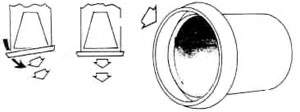jetavator

Jetavator diverting exhaust.
A jetavator is a control surface that may be moved into or against a rocket's jet stream to change the direction of the jet flow for thrust vector control. The jetavator is a variation of the jet-vane used on early rockets such as the V-2 and Redstone, to provide stabilization at takeoff. The jetavator is a ring placed around the circumference of the motor nozzle. Deflecting the ring deflects the exhaust, just as with vanes. However, the jetavator has the advantage of not causing propulsion losses when in the neutral position, since, unlike vanes, it does not interfere with the exhaust flow. Jetavators have been most frequently applied to control of solid-propellant rockets.


